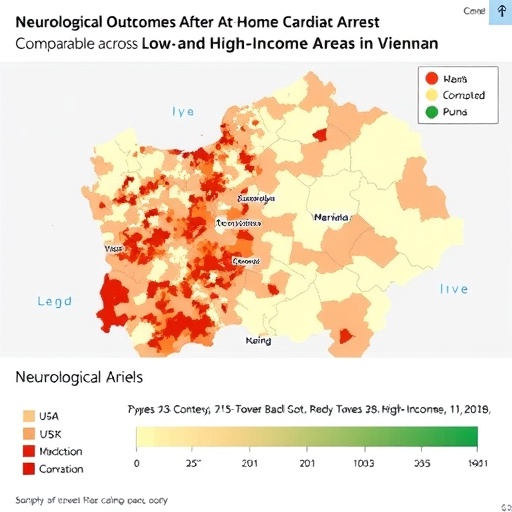Research in the realm of cancer biology has continuously unveiled the complex interplay of genetic and cellular mechanisms underpinning tumor progression and metastasis. In a groundbreaking study, researchers led by Wang et al. have drawn crucial insights into the role of NRF2, a transcription factor primarily known for its function in cellular defense mechanisms against oxidative stress, in ovarian cancer cell migration. Their findings, published in the Journal of Ovarian Research, suggest that NRF2 does not merely protect cells but actively contributes to the epithelial-mesenchymal transition (EMT), a critical process that allows cancer cells to invade surrounding tissues and disseminate to distant sites.
The significance of this research cannot be understated, as ovarian cancer remains one of the most lethal gynecological malignancies worldwide. The complexity of its pathology, coupled with the late-stage diagnosis often encountered, underscores the urgency of understanding the molecular drivers of its aggressiveness. NRF2’s involvement in promoting cellular migration offers a new perspective on therapeutic targets that could be crucial in diminishing tumor spread and improving patient outcomes.
Central to the study’s hypothesis is the role of TAGLN (transgelin), a protein that has been implicated in the modulation of cytoskeletal dynamics and cell motility. The authors painstakingly explored how NRF2 influences TAGLN expression and activity, ultimately facilitating the transition from an epithelial to a mesenchymal phenotype. This transition is instrumental in enabling cancer cells to gain migratory and invasive properties, thus further complicating treatment efforts.
Utilizing various ovarian cancer cell lines, the researchers employed a combination of in vitro assays to elucidate the mechanistic pathways at play. Through a series of elegantly designed experiments, they demonstrated that NRF2 directly upregulates TAGLN, leading to enhanced motility and invasiveness. This discovery adds a significant layer of complexity to our understanding of how oxidative stress responses can inadvertently promote malignancy.
Moreover, the implications of NRF2 activation extend beyond mere cellular migration. The study posits that the interaction between NRF2 and TAGLN may be part of a broader network of signaling pathways that govern cancer cell behavior in response to environmental cues. For instance, under oxidative stress conditions, the tumor microenvironment can modulate NRF2 activity, promoting an EMT that could ultimately lead to metastasis.
In dissecting the implications of these findings, one must consider the potential for therapeutic intervention. By targeting the NRF2 signaling pathway, researchers might develop novel strategies to inhibit the migratory and invasive capabilities of ovarian cancer cells. This could potentially be a game-changer in the context of treatment, particularly for patients diagnosed at advanced stages where traditional therapies may have limited efficacy.
Furthermore, the study provides a foundation for future research aimed at elucidating the broader roles of NRF2 in other cancer types. Given its ubiquitous expression in various tissues, the influence of NRF2 on cancer progression could potentially extend beyond gynecological malignancies. Subsequent investigations are necessary to ascertain whether the NRF2-TAGLN axis functions similarly in other cancer models, thereby broadening the scope of this critical research.
Importantly, the findings of Wang et al. may also contribute to refining the prognostic markers associated with ovarian cancer. The levels of NRF2 and TAGLN expression could serve as potential indicators of tumor aggressiveness and metastatic potential, aiding in the stratification of patients for more personalized treatment approaches.
As we dive deeper into the molecular intricacies of cancer biology, studies like this highlight the exciting opportunities that lie ahead. The interplay between established genetic pathways and novel regulatory mechanisms opens new avenues for exploration. The NRF2-TAGLN relationship serves as a poignant reminder of the complex dance between cellular defense mechanisms and their potential role in cancer progression.
Researchers and clinicians must remain vigilant about the implications of these findings. As the scientific community delves further into understanding the regulatory networks governing tumor behavior, collaborative efforts will be pivotal in translating these discoveries into clinically relevant therapies. The investigation of NRF2 not only illuminates a critical pathway in ovarian cancer but also serves as a testament to the resilience and adaptability of cancer cells in the face of therapeutic challenges.
In conclusion, Wang et al.’s study on NRF2 and its role in enhancing the migratory potential of ovarian cancer cells through TAGLN provides essential insights into the mechanisms driving metastatic behavior in this disease. As the quest for more effective treatment strategies continues, understanding the molecular underpinnings of cancer progression will be paramount. Future investigations that build upon this work hold the promise of unlocking new therapeutic avenues that could significantly impact patient survival and quality of life.
Subject of Research: The role of NRF2 in promoting ovarian cancer cell migration through targeting TAGLN and mediating epithelial-mesenchymal transition.
Article Title: NRF2 promotes the migration of ovarian cancer cell lines by targeting TAGLN mediated epithelial-mesenchymal transition.
Article References:
Wang, H., Zhang, P., Cheng, Q. et al. NRF2 promotes the migration of ovarian cancer cell lines by targeting TAGLN mediated epithelial-mesenchymal transition. J Ovarian Res 18, 213 (2025). https://doi.org/10.1186/s13048-025-01804-1
Image Credits: AI Generated
DOI: 10.1186/s13048-025-01804-1
Keywords: NRF2, ovarian cancer, cell migration, TAGLN, epithelial-mesenchymal transition, cancer research, therapeutic targets.
Tags: cytoskeletal dynamics in cancer cellsenhancing patient outcomes in gynecological malignancieslate-stage ovarian cancer diagnosis challengesmolecular drivers of tumor aggressivenessNRF2 role in cancer metastasisNRF2 transcription factor functionsovarian cancer cell migration mechanismsoxidative stress and cancer progressionresearch insights from Journal of Ovarian ResearchTAGLN influence on epithelial-mesenchymal transitiontherapeutic targets for ovarian cancerunderstanding cancer cell invasion processes





